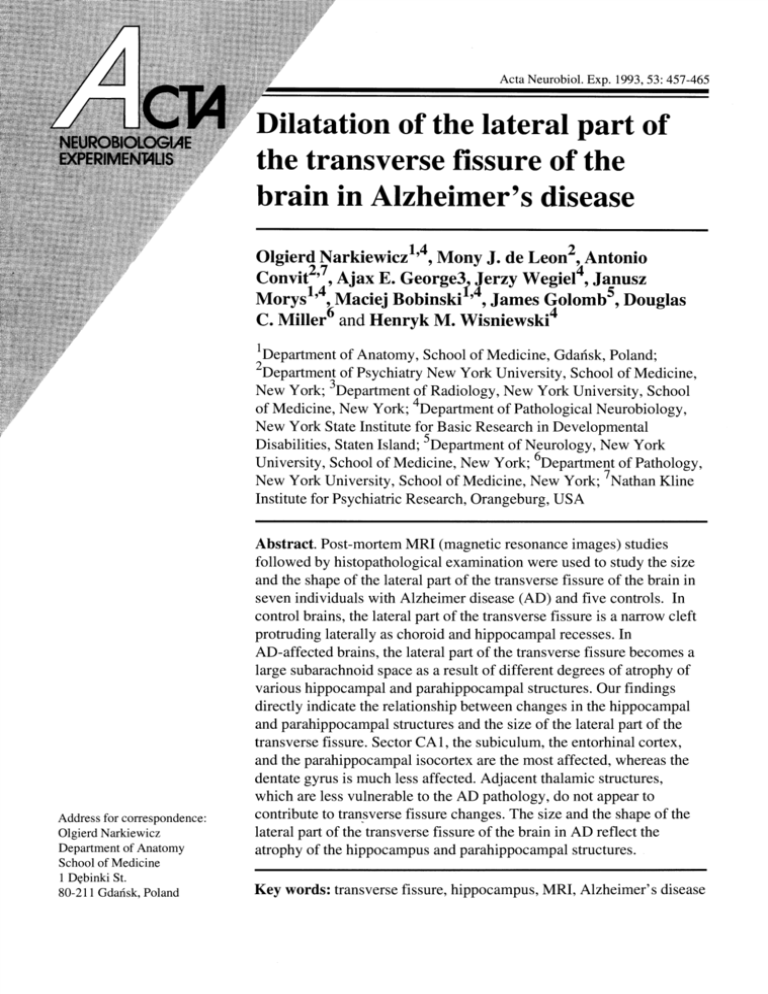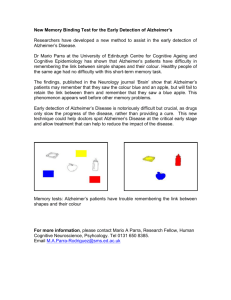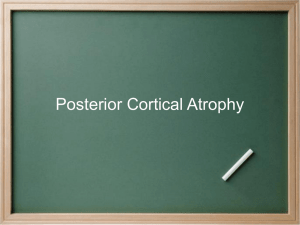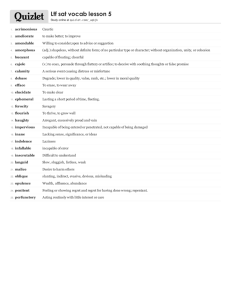ilatation of the lateral part of the transverse fissure of the brain in
advertisement

ilatation of the lateral part of the transverse fissure of the brain in Alzheimer's disease 'Department of Anatomy, School of Medicine, Gdalisk, Poland; 2~epartmentof Psychiatry New York University, School of Medicine, New York; 3~epartmentof Radiology. New York University, School of Medicine, New York; 4~epartment of Pathological Neurobiology, New York State Institute for Basic Research in Developmental Disabilities, Staten Island; 5 Department of Neurology, New York University, School of Medicine, New York; 6Department of Pathology, New York University, School of Medicine, New York; 7 ~ a t h a nKline Institute for Psychiatric Research, Orangeburg, USA Address for correspondence: Olgierd Narkiewicz Department of Anatomy School of Medicine 1 Dcbinki St. 80-211 Gdansk. Poland Abstract. Post-mortem MRI (magnetic resonance images) studies followed by histopathological examination were used to study the size and the shape of the lateral part of the transverse fissure of the brain in seven individuals with Alzheimer disease (AD) and five controls. In control brains, the lateral part of the transverse fissure is a narrow cleft protruding laterally as choroid and hippocampal recesses. In AD-affected brains, the lateral part of the transverse fissure becomes a large subarachnoid space as a result of different degrees of atrophy of various hippocampal and parahippocampal structures. Our findings directly indicate the relationship between changes in the hippocampal and parahippocampal structures and the size of the lateral part of the transverse fissure. Sector CA 1, the subiculum, the entorhinal cortex, and the parahippocampal isocortex are the most affected, whereas the dentate gyrus is much less affected. Adjacent thalamic structures, which are less vulnerable to the AD pathology, do not appear to contribute to transverse fissure changes. The size and the shape of the lateral part of the transverse fissure of the brain in AD reflect the atrophy of the hippocampus and parahippocampal structures. Key words: transverse fissure, hippocampus, MRI, Alzheimer's disease 458 0. Narkiewicz et al. INTRODUCTION Extensive pathology of the hippocampal formation has been reported in Alzheimer disease (AD), which has been characterized as a hippocampal dementia (Ball et al. 1985). The pathological changes include senile plaques, neurofibrillary tangles and granulovacuolar degeneration, and progressing neuronal loss leading to the atrophy of the hippocampal formation (Ball and Lo 1977, Ball 1978, Kemper 1984, Tomlinson and Corsellis 1984, Hyman et al. 1986, Hyman et al. 1988, McKee et al. 1990, 1991, Mizutani et al. 1990, Van Hoesen and Hyman 1990, Braak and Braak 1991, Brady and Mufson 1991, Struble et al. 1991). As the disease progresses, the hippocampal formation becomes partially disconnected from its major afferent and efferent pathways (Hyman et al. 1984).Neurotransmitter deficits and profound loss in the density of synaptic terminals contribute to the clinical picture of AD (Davies 1979, Hamos et al. 1989, Goto and Hirano 1990). The hippocampal atrophy seen on computed tomography (CT) and magnetic resonance images (MRI) correlates with the presence and the severity of Alzheimer disease (Seab et al. 1988, de Leon et al. 1989, George et al. 1990, Squire et al. 1990, Kesslak et al. 1991, Jobst et al. 1992). de Leon et al. (de Leon et al. 1988, 1992) and George et al. (George et al. 1990) observed dilatation of the lateral part of the transverse fissure of the brain in AD and suggested that it can serve as an indicator of hippocampal atrophy. Moreover, in cross-sectional and longitudinal radiological studies, they demonstrated the diagnostic and predictive value of hippocampal changes in the progress of AD (de Leon et al. 1989). The transverse fissure of Bichat (fissura transversa cerebri) separates the telencephalic structures from those of the diencephalon. It is composed of two parts: the medial, which separates the thalamus from the fornix and corpus callosum, and the lateral, which is situated between the thalamus and the parahippocampal gyrus. The lateral part of the transverse fissure (LTF) communicates medially with the ambient cistern (Caste1 et al. 1988, Duvernoy I 988, Nagata et al. 1988). Although the histopathology of the hippocampal formation in AD is well recognized, the pathology of the structures surrounding the LTF, as seen on MRT, is less understood. The purpose of this study is (I) to describe the LTF and surrounding structures as observed on MRI and in histopathological studies and (2) to examine in AD the relationships between the atrophy of hippocampus and surrounding structures, and the pathological changes of the LTF. METHODS The study was performed on 12 brains: seven from AD patients and five controls. The AD brains were collected by the NYUIIBR Alzheimer Disease Research Center and the control brains by the Department of Anatomy, School of Medicine in Gdansk. The control subjects were 7 1 to 79 years of age, and AD patients, 73 to 88 years of age. Within a few months before death, the AD patients were staged using the Global Deterioration Scale (GDS; Reisberg et al. 1982). One patient was rated as a GDS 6 (moderate to severe dementia), the remaining six were rated as 7 (severe dementia). The clinical records for the control material were examined and family members interviewed to establish normal functioning. The brains were fixed in 10% buffered formalin for one to three months. The fixed brains were scanned at 3-weeks of fixation, with formalin drained, in a plastic container. Brains were scanned in a supine-like position and aligned using LASAR lights with standard protocol which included both T1 and T2 weighted studies, using a Phillips 1.5 Tesla GYROSCAN MRT scanner. The TI images were obtained in sagittal, coronal and axial planes. The plane for the axial and coronal sections was determined from the sagittal study obtained with a 650130 sequence with a thickness of 6 mm with 20% gaps. The axial plane was established as the plane parallel to the visualized long axis of the LTF and the head and body of the hippocampus. The coronal plane was determined as the plane perpendicular to the axial plane. The axial and coronal images were obtained at the 650130 sequence with a three-mm-thickness with 10% gaps. Transverse fissure in Alzheimer's disease In the histologic study, all AD and control brains were cut on the coronal plane into five-mm-thick slabs. None of the brains had macroscopically detectable infarcts or other gross pathological changes. After embedding in paraffin, coronal eight-pm-thick serial sections were cut and stained with cresyl violet, hematoxylin-eosin, Bielschowsky silver, and Loyez methods. Clinical diagnosis of AD was confirmed by neuropathological examination, using the criteria recommended by the NIH (Khachaturian 1985). The control brains did not meet neuropathological criteria for AD. For all patients and controls the axial MRI images were rated for the extent of dilatation of the LTF. Also the atrophy of the hippocampal formation and parahippocampal gyrus was rated using the coronal MR images and histological slides. In addition, from the histological slides, atrophy of the lateral geniculate body and pulvinar was evaluated. For both MRI and histologic estimations, we used the following 4-point rating scale: no changes (0), mild (I), moderate (2) and severe (3). On coronal histological sections, morphometric studies were performed in each part of the hippocampus and parahippocampal gyrus on the level of the lateral geniculate body. Cross-sectional areas of all parts in these structures were measured using a projector (final magnification x28; DocumatorZeiss Jena) and morphometrical program SigmaScan (Jandel Scientific Corp.). The atrophy of the structures surrounding the LTF was estimated in comparison with the control brains and classified as follows: 0 - no changes; 1 - atrophy less than 20%; 2 - atrophy ranging between 20 to 40%; and 3 atrophy greater than 40%. RESULTS Coronal sections On coronal section, the dorsal and ventral surfaces and the fundus of the LTF can be distinguished (Fig. 1).Rostrally, the dorsal surface of the LTF is formed by the optic tract and the cerebral peduncle (not shown); and caudally, by the lateral ge- 459 niculate body and the pulvinar. The ventral surface is composed of the subiculum, presubiculum, and parasubiculum. In most brains, this subicular complex forms an elevation on the upper surface of the parahippocampal gyrus. The fundus of the LTF is formed by the dentate gyrus, the hippocampal fimbria, and the tela choroidea of the temporal horn of the lateral ventricle. The tela choroidea is attached to the lateral surface of the fimbria and forms the fundus of the choroid recess (also called choroid fissure), which is the most lateral extension of the LTF. The second extension of the LTF is the hippocampal recess. The fimbria forms the dorsal surface of the hippocampal recess and the subiculum, and/or presubiculum the ventral surface. The medial aspect of dentate gyrus forms the fundus. The hippocampal recess possesses two extensions: the fimbriodentate and hippocampal sulci. Dilatation of the lateral ventricle and the LTF, including hippocampal and choroid recesses, and changes in their shape are consistent features of AD brains (Fig. lB,D,F). Changes of the LTF occur together with the atrophy of both gray and white matter of the parahippocampal gyrus. The upper surface of the parahippocampal gyrus is flattened as aresult of atrophy of the subicular eminence. Alterations of the fundus of the LTF are associated with dilatation of both of its recesses. They are caused by atrophy of the hippocampus. In the hippocampal formation, numerous neuritic plaques and tangles appear, together with neuronal loss. The involvement of the hippocampal formation is not uniform, there are significant topographical differences in the distribution of plaques and tangles. The pyramidal layer of the cornu Ammonis and the cortex of the parahippocampal gyrus are mainly affected. Neuronal loss is the most extensive in the pyramidal layer of CAI and less prominent in the CA4, CA3, and CA2 sectors. No significant changes in the dentate gyrus are detectable. In two of seven AD brains, the size of the lateral geniculate body and the pulvinar-forming dorsal surface of the LTF was reduced. However, in those 460 0. Narkiewicz et al. Fig. 1. Coronal sections at the level of the lateral geniculate body of the control (A,C,E) and AD (B,D,F) brains. A and B, scheme; C and D, MRI; E and F, histological slides stained with Loyez method. In AD brain, the LTF is dilated, and the choroid (CR) and hippocampal (HR) recesses are enlarged. Atrophy of the parahippocampal gyms (PG) including the subiculum (S) is apparent. Hippocampal atrophy encompasses the cornu Ammonis (CA), sparring the dentate gyms (DG). Structures: Fi, Fimbria; HS, Hippocampal sulcus; LGB, Lateral geniculate body; LV, Lateral ventricle; PS, Presubiculum; TC, Tela choroidea, arrowhead - Fimbriodentate sulcus. Sagittal sections two cases the mild reductions do not appear to influence the size and the shape of the fissure. The diOn sagittal MRI sections of control brains (Fig. latation of the LTF appears to be more determined 2 A,C,E), the LTF appears as a narrow space sepby hippocampal and parahippocarnpal atrophy. The coronal plane MRI images of the AD brains arating the lateral geniculate body and the pulvinar (Fig. 1) were consistent with the previously de- from the parahippocampal gyms. The uncus forms scribed pathological changes that affect the hippo- the anterior surface of the fissure. The LTF is largest campus and parahippocampal gyms. In AD brains, just posterior to the uncus and protrudes rostrally the dilatation of the LTF including its choroid and and ventrally, forming the uncal sulcus, which sephippocampal recesses was also prominent on MRI. arates the uncus from the parahippocampal gyms. On the coronal MRI, the LTF and the lateral ven- At its anterior and posterior end, the LTF terminates tricle appeared as a large, uniform cerebrospinal at the tela choroidea, which separates the subarachnoid space from the lateral ventricle. fluid space without evident separation. Transverse fissure in Alzheimer's disease Fig. 2. Sagittal section of the LTF in the control (A,C) and AD (B,D) brains. A and B, schemes; C and D, MRI. In AD, the LTF is enlarged in dorsoventral dimen$ion; atrophy of the parahippocampal gym$ (PG) occurs as does severe atrophy of the uncus (Un). Structures: AA, Amygdaloid body; CR, Choroid recess; LGB, Lateral geniculate body; LV, lateral ventricle; Pul, Pulvinar; arrowheuds - Uncal sulcus. - c . =., sl(b.4 In AD atrophied brains (Fig. 2B,D,F), the LTF was enlarged in the dorsoventral dimension. The ventral surface was much lower than in normal brains due mainly to severe atrophy of the parahippocampal gyms. Axial sections On axial sections (Fig. 3), the LTF is bordered laterally by the dentate gyms and fimbria; rostrally by the uncus and head of the hippocampus; caudally by the parahippocampal gyms, and medially by the ambient cistern and cerebral peduncles. In the axial view the two extensions of the LFT are indistinct as a result of partial volume averaging. MRI of AD-affected brains (Fig. 3B,D,F) visualizes dilatation of the LTF almost along the whole length of the hippocampal body. The CSF space between the uncus and the parahippocampal gyms increases significantly. The enlargement of this CSF space is due predominantly to atrophy of the hippocampus and the parahippocampal gyms: the cases with moderate to severe hippocampal atrophy on axial scans were generally the cases that had the corresponding atrophy rating for the hippocampus and the parahippocampal gyms on the histopathological slides. 461 DISCUSSION The morphology of the LTF in pathological conditions is not well known, but its dilatation and changes of shape have been found in brains with pathology of the hippocampal formation (de Leon et al. 1988, 1989, 1992, George et al. 1990, Ambrosetto and Bacci 1991). CT and MRI studies suggest that these changes of the LTF are correlated with atrophy of the hippocampal formation (de Leon et al. 1988, 1992, George et al. 1990). However, the impact in AD of atrophy of different structures of this region on the size and the shape of the transverse fissure and its recesses has not been established. In normal brains, the LTF is a narrow cleft, which has been described in several anatomical (Lilequist 1959, Duvernoy 1988, Nagata et al. 1988) and MRI (Caste1 et al. 1988, Naidich et al. 1988, Sedat and Duvernoy 1990, Bronen and Cheung 1991a, 1991b, Tien et al. 1992) studies.The LTF is the lateral wing of the ambient cistern (Lilequist 1959, Duvernoy, 1988).This part of the transverse fissure has choroid and hippocarnpal recesses; the hippocampal recess possesses fimbriodentate and hippocampal sulci, which we distinguish in both anatomical and MRI studies. 462 0. Narkiewicz et al. Fig. 3. Axial section of the LTF in control (A,B) and AD (C,D) brains. A and C, scheme; B and D, postmortem axial MRI. Severe (D) dilatation of the LTF in AD brain. Atrophy of the cornu Arnrnonis (CA) and parahippocampal gyms (PG) is apparent. Structures: A, Ambient cistern; AA, Amygdaloid body; CP, Cerebral peduncle; DG, Dentate gyms; Ent, Entorhinal cortex; HH, Head of hippocampus; LV, Lateral ventricle; S, Subiculum; Un, Uncus; arrowheads - Hippocampal sulcus, arrow - Uncal sulcus. Pathological changes of LTF have been described in only a few papers (de Leon et al. 1988, 1989, 1992, George et al. 1990, Ambrosetto and Bacci 1991). The size and the shape of the LTF changed in AD, notably in the early stages of disease (de Leon et al. 1988,1992, George et al. 1990). They appear to be related to the pathology of the hippocampal structures and the parahippocampal gyms. Even slight atrophy of the bordering stmc- tures may result in the enlargement of the LTF. Our studies show several characteristic features of this pathology: (1) the atrophy of the parahippocampal gyms causes the dilatation of the LTF in the dorsoventral dimension; (2) atrophy of the hippocampal body enlarges the choroid and hippocampal recesses of the LTF; and (3) in AD, alteration of the size and the shape of the LTF and its recesses is caused by uneven atrophy of the hippocampal and parahippocampal structures. Pathological changes in the parahippocampal gyms are common and possible even in early stages of AD (Ball 1978, Hyman et al. 1984, Kemper 1984, Ball et al. 1985, Van Hoesen and Hyman 1990).MRI studies have shown reductions by more than 40% in the volume of the parahippocampal gyms (entorhinal cortex) in AD brains (Kesslak et al. 1991).The atrophy is associated with cellularpathology. Neurofibrillary changes are extensive and are related to massive neuronal loss, mainly in the superficial layers of the entorhinal cortex (Hyman et al. 1987, 1988, Hyman and Van Hoesen 1989, Arnold et al. 1991, Van Hoesen et al. 1991, Bobinski et al. 1992,Morys et al. 1992). Also, the subiculum is consistently and densely affected with neurofibrillary tangles (NFTs) with corresponding cell loss (33-42%) (Shefer 1973, 1978, Hubbard and Anderson 1985, Arnold et al. 1991, Bobinski et al. 1992, Morys et al. 1992). The shape of the LTF changes mainly as a result of different degrees of atrophy of the hippocampal structures and the parahippocampal gyms. Neuropathological studies reveal significant topographical differences in neuronal loss and numbers of NFTs and neuritic plaques (Ball 1978, Kemper 1978, Braak and Braak 1985, 1990, 1991, Van Hoesen et al. 1986, Kalus et al. 1989, Akiyama et al. 1990, Bobinski et al. 1992, Morys et al. 1992). Sector CAI, the subiculum, the entorhinal cortex, and the parahippocampal isocortex are the most affected in contrast to the dentate gyms, which shows only slight atrophy. Also the lateral geniculatebody and the pulvinar of the thalamus, which form the dorsal surface of the LTF, are seldom atrophic or affected by these pathologic changes. Tansverse fissure in Alzheimer's disease On the basis of our observations, we conclude that changes in size and shape of the LTF of the brain are good markers of hippocampal and parahippocampal atrophy. They are distinguishable in both the coronal and sagittal planes. However, the axial CT or MRI sections enable the most complete assessment of the AD atrophy in this region. Only this plane shows the whole hippocampal body and its relationship both to the LTF and to the lateral ventricle. Therefore, we propose that visualizing the hippocampal formation on the axial view is especially useful in the diagnosis and evaluation of AD pathology. ACKNOWLEDGEMENTS The authors wish to thank Mr. Kenneth Anderson for expert technical assistance in the MRI studies and Mrs. Maureen Stoddard Marlow for copy-editing the manuscript. This research was supported by funds from the National Institute on Aging Alzheimer Disease Core Center, Grant P30AG0805 1, the National Institute of Mental Health ROI MH43965 and New York State Office of Mental Retardation and Developmental Disabilities and a grant from the National Institutes of Health, National Institute on Aging, Grant No. PO 1-AGO-4220. REFERENCES Akiyama H., Tago H., Itagaki S., McGeer P.L. (1990) Occurence o f diffuse amyloid deposits in the presubicular parvopyramidal layer in Alzheimer's disease. Acta Neuropathol. (Berl.) 79: 537-544. Ambrosetto P., Bacci A. (199 1 ) CT diagnostic features o f choroidal/hippocampal fissure complex in Alzheimer disease and progressive supranuclear palsy. AJNR 12: 583-584. Arnold S.E., Hyman B.T., Flory J., Damasio A.R., Van Hoesen G.W. (1991) The topographical and neuroanatomical distribution o f neurofibrillary tangles and neuritic plaques in the cerebral cortex o f patients with Alzheimer's disease. Cerebral Cortex I : 103- 1 16. Ball M.J. (1978) Topographic distribution o f neurofibrillary tangles and granulovacuolar degeneration in hippocampal cortex o f aging and demented patients. A quantitative study. Acta Neuropathol. (Berl.)42: 73-80. 463 Ball M.J., Fisman M., Hachinski V . , Blume W . , Fox A., Kral V.A., Kirshen A.J., Fox H., Merskey H. ( 1 985) A new definition o f Alzheimer's disease: a hippocampal dementia. Lancet 1 : 14-16. Ball M.J., Lo P. (1977) Granulovacuolar degeneration in the ageing brain and in dementia. J. Neuropathol. Exp. Neurol. 36: 474-487. Bobinski M., Morys J., Wegiel J., de Leon M.J., Miller D.C., Wisniewski H.M. (1992) Topography o f pathological changes in the hippocampal formation in AD. J . Neuropathol. Exp. Neurol. 5 1 : 3 18. Braak H., Braak E. (1985) On areas o f transition between entorhinal allocortex and temporal isocortex in the human brain. Normal morphology and lamina-specific pathology in Alzheimer's disease. Acta Neuropathol. (Berl.) 68: 325-332. Braak H., Braak E. (1990)Neurofibrillary changes confined to the entorhinal region and an abundance o f cortical amyloid in cases o f presenile and senile dementia. Acta Neuropathol. (Berl.) 80: 479-486. Braak H., Braak E. ( 1 99 1 ) Neuropathological stageing o f Alzheimer-related changes. Acta Neuropathol. (Berl.) 82: 239-259. Brady D.R., Mufson E.J. ( 1 991) Alz-50 immunoreactive neuropil differentiateshippocampal complex subfields in Alzheimer's disease. J . Comp. Neurol. 305: 489-507. Bronen R.A., Cheung G . ( 1 99 1 a) Relationship o f hippocampus and amygdala to coronal MRI landmarks. Magn. Reson. Imaging 9: 449-457. Bronen R.A., Cheung G . (1991b) MRI o f the normal hippocampus. Magn. Reson. Imaging 9: 497-500. Caste1 J.C., Destandau J., Kien P., Caille J.M. (1988) Magnetic resonance imaging o f the transverse fissure (fissura transversa cerebri). In: Brain anatomy and magnetic resonance imaging (Eds. A. Gouaze and G. Salamon). Springer-Verlag, Berlin, p. 150- 157. Davies P. ( 1 979) Neurotransmitter-related enzymes in senile dementia o f the Alzheimer type. Brain Res. 17 1: 3 19-327. de Leon M.J., George A.E., Stylopoulos L.A., Smith G., Miller D.C. (1989)Early marker for Alzheimer's disease: the atrophic hippocampus. Lancet 2:672-673. de Leon M.J., McRae T., Tsai J.R., ~ e o r g A.B., e Marcus D.L., Freedman M., W o l f A.P., McEwen B. (1988) Abnormal cortisol response in Alzheimer's disease linked to hippocampal atrophy. Lancet 2: 39 1-392. de Leon M.J., Smith G., Convit A,, George A.E., Golomb J., Flicker C., McRaeT., Kluger A., Tsui W . , Rusinek H., Ferris S.H., Reisberg B., Ciaravino J., Wegiel J., Narkiewicz O., Wisniewski H., W o l f A.P. (1992) The early detection o f brain pathology in Alzheimer's disease. In: Neurophilosophy and Alzheimer's disease (Eds. Y . Christen, and P. Churchland). Springer-Verlag. Berlin, p. 13 1-143. Duvernoy H.M. (1988)The human hippocampus. An atlas o f applied anatomy (Ed. J.F.Bergmann). Verlag, Munchen, p. 1-166. 464 0.Narkiewicz et al. George A.E., de Leon M.J., Stylopoulos L.A., Miller J., Kluger A., Smith G., Miller D.C. (1990) CT diagnostic features of Alzheimer disease: importance of the choroidallhippocampal fissure complex. AJNR 1 1 : 101- 107. Goto S., Hirano A. (1990) Neuronal inputs to hippocampal formation in Alzheimer's disease and in parkinsonismdementia complex on Guam. Acta Neuropathol. (Berl.) 79: 545-550. Hamos J.E., DeGennaroL.J., DrachmanD.A. (1989) Synaptic loss in Alzheimer's disease and other dementias. Neurology 39: 355-361. Hubbard B.M., Anderson J.M. (1985) Age-related variations in the neuron content of the cerebral cortex in senile dementia of Alzheimer type. Neuropathol. Appl. Neurobi01. 11: 369-382. Hyman B.T., Kromer L.J., Van Hoesen G.W. (1987) Reinnervation of the hippocampal perforant pathway zone in Alzheimer's disease. Ann. Neurol. 21: 259-267. Hyman B.T., Kromer L.J., Van Hoesen G.W. (1988) A direct demonstration of the perforant pathway terminal zone in Alzheimer's disease using the monoclonal antibody Alz50. Brain Res. 450: 392-397. Hyman B.T., Van Hoesen G.W. (1989) Hoppocampal and entorhinal cortex cellular pathology in Alzheimer's disease. In: The hippocampus. New vistas (Eds. Chan-Palay and C. Kohler). Alan R. Liss Inc., New York, p. 499-5 12. Hyman B .T., Van Hoesen G.W., Damasio A.R., Barnes C.L. (1984) Alzheimer's disease: cell-specific pathology isolates the hippocampal formation. Science 225: 1 168-1 170. Hyman B.T., Van Hoesen G.W., Kromer L.J., Damasio A.R. (1986) Perforant pathway changes and the memory impairment of Alzheimer's disease. Ann. Neurol. 20: 11681170. Jobst K.A., Smith A.D., Barker C.S., Wear A., King E.M., Smith A., Anslow S.A., Molyneux A.J., Shepstone B.J., Soper N., Holmes K.A., Robinson J.R., Hope R.A., Oppenheimer C., Brockbank K., McDonald B. (1992) Association of atrophy of the medial temporal lobe with reduced blood flow in the posterior parietotemporal cortex in patients with a clinical and pathological diagnosis of Alzheimer's disease. J. Neurol. Neurosurg. Psychiatry 55: 190-194. Kalus P., Braak H., Braak E., Bohl J. (1989) The presubicular region in Alzheimer's disease: topography of amyloid deposits and neurotibrillary changes. Brain Res. 494: 198-203. Kemper T. (1978) Senile dementia: afocal disease in the temporal lobe. In: Senile dementia. A biomedical approach. (Ed. K. Nandy). Elsevier, North-Holland, p. 105-1 13. Kemper T. (1984) Neuroanatomical and neuropathological changes in normal aging and in dementia. In: Clinical neurology of aging (Ed. M.L. Albert). Oxford University Press, New York, p. 9-52. Kesslak J.P., Nalcioglu O., Cotman C.W. (1991) Quantification of magnetic resonance scans for hippocampal and parahippocampal atrophy in Alzheimer's disease. Neurology 41 : 5 1-54. Khachaturian Z.S. (1985) Diagnosis of Alzheimer's disease. Arch. Neurol. 42: 1097- 1105. Lilequist B. (1959) The subarachnoid cisterns. An anatomic and roentgenologic study. Acta Radiol. (Suppl.) 185: 61-7 1. McKee A.C., Kosik K.S., Kennedy M.B., Kowall N.W. (1990) Hippocampal neurons predisposed to neurofibrillary tangle formation are enriched in type I1 calcium/calmodulin-dependent protein kinase. J. Neuropathol. Exp. Neurol. 49: 49-63. McKee A.C., Kosik K.S., Kowall N.W. (1991) Neuritic pathology and dementia in Alzheimer's disease. Ann. Neurol. 30: 156- 165. Mizutani T., Amano N., Sasaki H., Morimatsu Y., Mori H., Yoshimura M., Yamanouchi H., Hayakawa K., Shimada H. (1990) Senile dementia of Alzheimer type characterized by laminar neuronal loss exclusively in the hippocampus, parahippocampus and medial occipitotemporal cortex. Acta Neuropathol. (Berl.) 80: 575-580. Morys J., Bobinski M., Wegiel J., Wisniewski H.M. (1992) Hippocampal pathology in Alzheimer disease - 3-D reconstruction and morphometric study. Acta Neurobiol. Exp. 52: 139. Nagata S., Rhoton A.L., Barry M. (1988) Microsurgical anatomy of the choroidal fissure. Surg. Neurol. 30: 3-59. Naidich T.P., Daniels D.L., Haughton V.M., Williams A., Pech P., Pojunas K., Palacios E. (1988) The hippocampal formation and related structures of the 1 limbic lobe: Anatomic - magnetic resonance correlation. In: Brain anatomy and magnetic resonance imaging. (Eds. A. Gouaze and G. Salamon). Springer-Verlag, Berlin, p. 32-64. Reisberg B., Ferris S.H., de Leon M.J., Crook T. (1982) The Global Deterioration Scale (GDS): an instrument for the assessment of primary degenerative dementia (PDD). Am. J. Psychiatry. 139: 1136-1 139. Seab J.P., Jagust W.J., Wong S.T., Roos M.S., Reed B.R., Budinger T.F. (1988) Quantitative NMR measurements of hippocampal atrophy in Alzheimer's disease. Magn. Reson. Med. 8: 200-208. Sedat J., Duvernoy H. (1990) Anatomical study of the temporal lobe. Correlations with nuclear magnetic resonance. J. Neuroradiol. 17: 26-49. Shefer V.F. (1973) Absolute number of neurons and thickness of the cerebral cortex during aging, senile and vascular dementia, and Pick's and Alzheimer's diseases. Neurosci. Behav. Physiol. 6: 319-324. Shefer V.F. (1978) Hippocampal pathology as a possible factor in the pathogenesis of senile dementias. Neurosci. Behav. Physiol. 8: 236-239. Squire L.R., Amaral D.G., Press G.A. (1990) Magnetic resonance imaging of the hippocampal formation and mammillary nuclei distinguish medial temporal lobe and diencephalic amnesia. J. Neurosci. 10: 3 106-3 1 17. Transverse fissure in Alzheimer's disease Struble R.G., Polinsky R.J., Hedreen J.C., Nee L.E., Frommelt P., Feldman R.G., Price D.L. (1991) Hippocampal lesions in dominantly inherited Alzheimer's disease. J. Neuropathol. Exp. Neurol. 50: 82-94. Tien R.D., Felsberg G.J., Crain B. (1992) Normal anatomy of the hippocampus and adjacent temporal lobe -high-resolution fast spin-echo MR Images in volunteers correlated with cadaveric histologic sections - pictorial essay. Am. J. Roentgenol. 159:1309-13 13. Tomlinson B.E., Corsellis J.A.N. (1984) Ageing and dementias. In: Greenfield's Neuropathology. 4th ed. (Eds. J.H. Adams and J.A.N. Corsellis). L.W. Duchen Wiley, New York, p. 95 1 - 1025. 465 Van Hoesen G.W., Hyman B.T., Damasio A.R. (1986) Cellspecific pathology in neural systems of the temporal lobe in Alzheimer's disease. In: Aging of the brain and Alzheimer's disease. (Eds. D.F. Swaab, E. Fliers, M. Mirmiran, W.A. Van Goo1 and F. Van Haaren). Elsevier, Amsterdam, p. 32 1-335. Van Hoesen G.W., Hyman B.T. (1990) Hoppocampal formation: anatomy and the patterns of pathology in Alzheimer's disease. Prog. Brain Res. 83: 445-457. Van Hoesen G.W., Hyman B.T., Damasio A.R. (1991) Entorhinal cortex pathology in Alzheimer's disease. Hippocampus 1: 1-8. Received 2 April 1993, uccepted 28 Muy 1993









